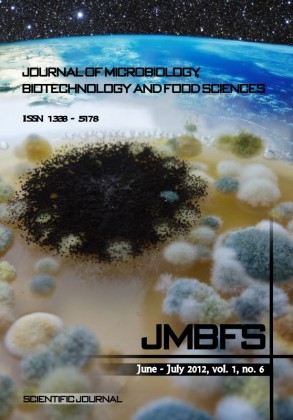PRODUCTION OF PLANTARCIN BY LACTOBACILLUS PLANTARUM SR18
Keywords:
Lactobacillus plantarum, Bacteriocin, plasmid, UV inductionAbstract
Out of 86 lactobacilli previously screened in our laboratory, Lactobacillus plantarum SR18 isolated from yoghurt revealed the largest detected inhibition zone against the selected indicator Streptococcus salivarius 5. The obtained electrophoretic patterns revealed that L. plantarum SR18 was free from plasmids. Exposure of 6 h growing L. plantarum culture to T-8M, 3B ultraviolet B lamp (8w, 220v & 312 nm) for 2 h and subsequent growth for further 24 h resulted in an increase of cell-bound bacteriocin titer reached 2 fold at 12 h. Whereas bacteriocin secreted in the culture filtrate was not affected by UV irradiation. Plantarcin SR18 production was maximal (12800 AU/ml) between 12 and 18 h by incubation of the culture at 37°C and pH 5-7 in candle jar (CO2). The bacteriocin bound to the cells and that secreted into the culture filtrate of L. plantarum SR18 were precipitated by 75% ammomium sulphate, dialysed and further purified by Gel filtration on Sephadex G-100. The specific activities (AU/mg protein) were increased by a factor of about 5.3 and 2.35 for plantarcins purified from proteins bound to the cell of L. plantarum SR18 (plantarcin SR18 a) and that secreted into the culture filtrate (plantarcin SR18 b), respectively. Gel filtration of plantarcin SR18a resulted in moderate antibacterial activity (3200 AU/ml) and very high activity (25600 AU/ml) of plantarcin SR18b.Downloads
Download data is not yet available.
Downloads
Published
2012-06-01
How to Cite
El-Shouny*, W., Abo-Kamar, A., El-Raheem El-Shanshoury, A., & Ragy, S. (2012). PRODUCTION OF PLANTARCIN BY LACTOBACILLUS PLANTARUM SR18. Journal of Microbiology, Biotechnology and Food Sciences, 1(6), 1488–1504. Retrieved from https://office2.jmbfs.org/index.php/JMBFS/article/view/7224
Issue
Section
Microbiology
License
Copyright (c) 2012 Wagih El-Shouny*, Amal Abo-Kamar, Abd El-Raheem El-Shanshoury, Suzan Ragy

This work is licensed under a Creative Commons Attribution 4.0 International License.
All papers published in the Journal of Microbiology, Biotechnology and Food Sciences are published under a CC-BY licence (CC-BY 4.0). Published materials can be shared (copy and redistribute the material in any medium or format) and adapted (remix, transform, and build upon the material for any purpose, even commercially) with specifying the author(s).

